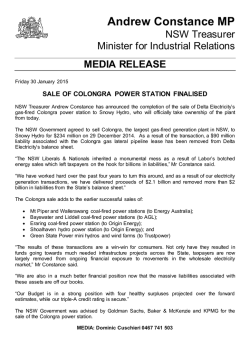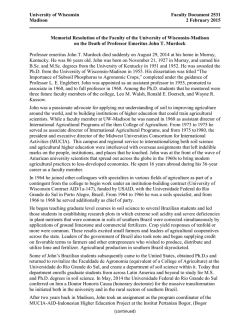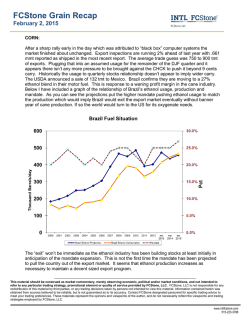
Type here the title of your Paper
21, rue d’Artois, F-75008 PARIS Study Committee C1 CIGRE 2014 PS2 – New System Solutions and http : //www.cigre.org Planning Techniques FACTS and D-FACTS: The Operational Flexibility Demanded by the Transmission Expansion Planning Task with Increasing RES R. C. Perez*, G. C. Oliveira, M. V. Pereira, D. M. Falcão, F. Kreikebaum, S. M. Ramsay PSR PSR PSR UFRJ SWG SWG Brazil and USA SUMMARY There are several reasons to explain why transmission system loading is less than 100%. These reasons include: (i) reliability, (ii) uncertainties associated with the demand growth forecast and (iii) different dispatch scenarios due to Renewable Energy Sources (RES), i.e., hydroelectricity, modern biomass, wind and solar power. The combination of these facts leads to high investments in the transmission systems to meet different dispatch scenarios and low loading throughout the year. In hydrothermal systems as in the case of Brazil, the economic dispatches vary throughout the year due to the hydrology associated to the rivers located in different regions of the country. Therefore, the transmission expansion plan must be robust enough to meet the demand with completely different dispatch scenarios throughout the year. Furthermore, the aforementioned issue concerning transmission expansion planning was historically not a significant problem for the United States and most European countries. However, with the high penetration of intermittent renewables, such as wind and solar, the transmission expansion planning has become a task of extreme technical and economic importance, as it already is for Brazil. Recent technological advances have revealed new equipment that has as primary objective to increase the flexibility and controllability of the transmission system: • FACTS (Flexible AC Transmission Systems): equipment based on power electronics or other static technologies, which aim to directly control physical quantities of the transmission system, primarily to control voltage or power flow; • Distributed Series Reactors (DSRs), a distributed FACTS (D-FACTS) power flow controller which operates by varying line reactance. DSRs are attached concentrically around the conductor. Adding FACTS and D-FACTS to the system allows greater control of the active power flow and greater operational flexibility to accommodate different dispatch scenarios. The main purpose of this paper is to analyse these impacts in transmission expansion planning and operation and also the associated financial impact. To achieve this goal, case studies based on the Brazilian system with different dispatch scenarios will be utilized to compare the available technologies to realize the transmission expansion planning task. The expansion plans will be compared based on operational performance and total investments. KEYWORDS Transmission Expansion Planning, Renewable Energy Sources, FACTS, D-FACTS, Distributed Series Reactor, DSR. 1 1 INTRODUCTION The Brazilian Ten Year Plan for Energy Expansion 2022 (PDE 2022 [1]) foresees investments of US$ 130 billion in the period 2013-2022 in new generation and transmission projects. The generation expansion will total US$ 100 billion, with emphasis on hydro, wind and other renewables. Brazil is also a transmission-intensive country: an expansion of just over 104 thousand kilometers was observed in 2012 and it expected its high-voltage grid will increase its length to 155,736 km until 2022. Accordingly, the Brazilian power system features a large planned generation and transmission expansion. These facts further emphasize the importance of this paper by developing an optimized transmission expansion plan that considers new line construction as well as adding FACTS and D-FACTS. An optimized plan is important because of the potential for overinvestment as a consequence of the need to accommodate the multiple dispatch scenarios as a consequence of the RES. 2 THE GENERATION DISPATCH PROBLEM As explained in the summary, there are several reasons to explain why transmission system loading is less than 100% and why the transmission expansion planning task is a complicated optimization problem. In summary, these reasons are: redundancy for reliability, uncertainties associated with the demand growth forecast, the binary nature of line construction and the different dispatch scenarios associated with the RES. The transmission expansion plan must be robust to meet all these requirements. As can be seen, apart from complicated handling requirements, the transmission expansion planning also depends on the generation patterns associated with RES which in turn depend on river flow, wind and solar radiation. The physical processes are stochastic. This chapter aims to present the main concepts and characteristics of the generation dispatch problem. This problem has a high importance to this work, since the aim of this paper is to analyse methodologies to obtain flexible and therefore robust expansion plans to suit different dispatch scenarios with minimum cost. The Brazilian system is hydrothermal. Figure 1-a), presented below, spans an area corresponding to 4,400 km in the vertical dimension and shows the localization of the hydro basins in Brazil as indicated by the blue circles [2]: Figure 1: a) Hydro Basins in Brazil and b) Evolution of the regularization capacity As can be seen, the hydro basins are scattered throughout the territory with large distances between them. So, the economic dispatches vary throughout the year due to the hydrology associated with the various rivers and the requirement that the transmission system support the different dispatch scenarios and span long distances. Moreover, there is a long-term reduction on the hydro contribution 2 mainly because of two reasons: the majority of the high-potential projects have already been built and new hydro projects with reservoirs are impractical due to environmental barriers. Today in Brazil, the majority of new hydroelectric projects are run-of-river. The Figure 1-b) shows the regulating capacity for 2014-2030. The regulating capacity is the ratio between the Maximum Energy Storable and the average of the annual Natural Energy Inflow (ESmax/ENA), or in other words the percentage of natural energy inflow that could be stored and transferred [3]. It can be seen that regulating capacity is projected to decrease. Consequently, it is more difficult to fulfil the role of energy reserve when requested. Accordingly, as the hydro inflow data is volatile, an expansion based on run-of-river hydro plants increases the importance of a robust and flexible transmission system. In addition to that hydro contribution reduction and loss of regularization capacity, the amount of installed wind capacity is projected to expand worldwide and in Brazil: • Globally: from 283 GW in 2012 to 475 GW in 2016 (13.5% p.a.). • Brazil: from 1.9 GW in 2012 to 10 GW in 2016 (48% p.a.). In Brazil, there are basically four "Wind Basins", regions that concentrate most of the technical and economic wind potential (Bahia - BA, Ceará - CE, Rio Grande do Norte - RN and Rio Grande do Sul RS). In order to show the exacerbated uncertainties of hydro and wind generation, Figure 2-a) presents the historical inflow data of the monthly sum of all Brazilian hydro’s ENA (red curves) in conjunction with the wind series from the CE “Wind Basin” (blue curves), which presents the largest typical seasonal variability. Each year is represented by a different line [4]. Figure 2: a) Uncertainties in hydro and wind generation and b) Seasonal generation profile according to each “wind basin” As can be seen the ENA data is very volatile, especially in the wet season (December to April), and the wind inflow data also. These uncertainties make up the main reason why the transmission expansion planning is such a challenging task. Figure 2-b) shows the seasonal generation profile according to each “wind basin”, for example, the curve “Wind-CE” shows the average of all blue curves present in Figure 2-a). Besides these curves, the average of all red curves is also presented in order to compare the seasonal differences between wind and hydro [4]. An advantage of a hydrothermal system with high wind penetration is the reverse seasonality in comparison to the hydro’s ENA. Another advantage of is that hydroelectric plants have a fast power response, i.e., they can absorb with relative ease momentary fluctuations in wind generation time. 3 2.1 How to determine the dispatch scenarios with so many aforementioned uncertainties? The objective of hydrothermal scheduling is to determine an operation strategy of a hydrothermal system (as is the case of Brazil) that for each stage of the planning period produces generation targets for each plant. This strategy should minimize the expected value of the operation cost along the period, composed of fuel cost and penalties for unserved load, while operating within area interchange limits. Different from thermal plants, hydro units do not have fuel costs, i.e., direct operating costs. As the energy can be stored in the reservoir, hydro plants may displace fuel cost today or in the future. This opportunity cost is called “water value”. In Brazil, hydro plants are centrally dispatched by an ISO based on their marginal water values, which are computed by a multi-stage stochastic optimization methodology, Stochastic Dual Dynamic Programming (SDDP) [5]. The SDDP algorithm has been applied to the scheduling of large-scale power systems in more than sixty countries, including detailing modelling of system components and transmission networks [6]. 2.2 Summary In hydrothermal systems, as in the case of Brazil, the economic dispatches vary throughout the year due to the hydrology associated to the rivers located in different regions of the country. In addition to that, there is an expansion of installed wind capacity. Both RES present a volatile inflow data and consequently exacerbated uncertainties. Therefore, the transmission expansion plan must be robust enough to meet the demand with completely different dispatch scenarios throughout the year meeting while also transporting across Brazil. The combination above results in high investments in the transmission systems. These facts further emphasize the importance of operational flexibility in order to result in cost savings in the long-term transmission expansion planning task. The next chapter will introduce the power flow controllers that enable flexibility. 3 FACTS AND D-FACTS CONTROLLERS Recent technological advances have revealed new equipment that has as primary objective to increase the flexibility and controllability of the transmission system. This paper focuses on the use of series FACTS and D-FACTS to control power flow. 3.1 Flexible AC Transmission Systems (FACTS) FACTS leverage power electronics to directly control physical quantities of the transmission system, primarily voltage or power flow. This paper considers one FACTS controller, the Thyristor Controlled Series Capacitor (TCSC) as it is the most widely deployed FACTS for power flow control. The TCSC is a series capacitor connected in parallel with a thyristor controlled reactor (TCR). By varying the firing angle of the TCR, the injected impedance of the TCSC can be varied from capacitive to inductive. The TCSC has been commercially available for at least twenty years. The TCR is typically installed in a substation on a platform that is electrically isolated from ground. 3.2 Distributed FACTS (D-FACTS) D-FACTS were introduced by Professor Deepak Divan in the early 2000s. D-FACTS provide the functionality of FACTS via a number of modular controllers installed along the transmission line. As a modular solution attached to the transmission conductor, D-FACTS provide high reliability, low cost, and short lead times. In addition, D-FACTS are redeployable and do not require permitting or substation space. This paper focuses on one type of D-FACTs, the Distributed Series Reactor (DSR), as it is currently the only commercially available D-FACTS device. The DSR can increase line impedance. The DSR, shown below, operates by shorting or opening the secondary of a single-turn transformer. 4 Figure 3: a) Topology of the Distributed Series Reactor (DSR) and b) DSR installed on a transmission line Both FACTS and D-FACTS enable greater control of the active power flow in the circuits and greater operational flexibility against different dispatch scenarios. The main purpose of this paper is to analyse these impacts in the transmission expansion planning and operation and also the associated financial impact. 4 THE TRANSMISSION EXPANSION PLANNING PROBLEM To achieve the goals of the paper, two different transmission expansion planning methodologies will be applied in the case study system: considering or not Candidate Series Compensation Devices (CSCDs), i.e., the first one considers only line candidates and the second one, lines and CSCDs. These methodologies are formulated as mixed integer linear optimization models based on the linearized power flow and circuit limits where the objective is to minimize the investments in the transmission system. The proposed transmission expansion planning models consider only the steady state of the network and adopt the linearized active power flow instead of the non-linear power flow due to the following reasons: • The linearized model provides a good approximation for power flows in meshed high voltage networks due to the low typical resistance-to-reactance (R/X) ratio of overhead transmission lines; • It avoids convergence problems that are common in non-linear power flow calculations, especially in systems lacking of reactive support which is the case of expansion planning study cases; • VAr support requirements are local in nature and can be provided by shunt compensation; • VAr support requirements present minor costs with respect to circuit investment costs (transmission lines, transformers, etc.); • Optimization solvers for Mixed Integer Programming (MIP) can be used to determine the optimal expansion plan. This study has leveraged from the availability of the commercial tool to transmission expansion under uncertainty developed by PSR named NetPlan®. A full description of the proposed transmission expansion planning optimization models, including the integration of CSCDs, can be found in [7]. 5 CASE STUDY: THE BRAZILIAN SYSTEM The case study used in this paper is based on the Brazilian system. Furthermore, the Northeast Region was chosen for the analysis because (i) it is the region with major load growth, (ii) it contains important hydro plants in the region (Paulo Afonso, Xingó, Sobradinho, etc.) and (iii) it contains the regions with most of the technical and economic wind potential. The full Brazilian system and the Northeast Region are shown in Figures 3-a) and 3-b) respectively. The configuration under analysis is December 2016 (5822 buses and 8432 circuits), the network data were obtained from the “Plano de 5 Ampliação e Reforços (PAR)” Data Base [2], prepared by the ISO, and the network diagrams were generated with GIS information in the NetPlan®1 model. Figure 4: a) Brazilian System and b) Northeast Equivalent System Before analysing the Northeast Region, it is necessary to calculate the dispatches for each power plant in the whole Brazilian system for each scenario to be considered. To do so, a simulation called Stochastic Optimization of Multireservoir Hydroelectric System was performed using the SDDP®2 model with the “Programa Mensal da Operação (PMO)” Data Base [2]. The SDDP considers dispatches generation over a multi-year period while enforcing area interchange limits. In addition to providing power plant dispatches, this simulation provides the data to reduce the system to the Northeast Region, thus reducing the computational effort of the case study analysis. 5.1 Dispatch Scenario Selection In order to consider the variability of generation dispatches in the transmission planning process for the Northeast region, the differences between intra-region dispatches and self-sufficiency of the region’s generation are important. Therefore, having all dispatch scenarios resulting from the SDDP ® execution, five were selected according to the following criterion: k-th percentile of the total northeast generation, i.e., P1, P25, P50, P75 and P100 of the whole probability distribution. More than capturing dispatch variability, this criterion encompasses the case with maximum power import (scenario P1) and also maximum power export (scenario P100). This dispatch scenario selection has proven to be efficient in order to illustrate the proposed methodology as will be seen in the results. 5.2 Lines, FACTS and D-FACTS Candidate Selection When running the DC power flow model with the December 2016 network configuration, the network expansion plan for 2013-2016 is sufficient to eliminate all overloads in the system. While the Brazilian system expansion planning imposes N-1 criterion, this paper imposes no security constraint. 1 NetPlan: commercial Network Expansion Tool (NXT) developed by PSR which is composed by a set of mathematical models for transmission network analysis and expansion planning integrated within the graphical user interface. 2 Stochastic Dual Dynamic Programming: commercial simulation tool developed by PSR that is capable of calculating the minimum cost stochastic operating policy of a hydrothermal system considering operating details of the power plants and transmission system as well as constraints on natural gas supply and stochastic hydrology inflows. 6 Therefore, the lines of the expansion plan 2013-2016 were considered as candidates. In addition to that, as one of the goals of this paper is to evaluate the influence of series compensation in the transmission expansion planning, 500 kV existing lines that include compensation were also considered as candidates. For all candidate lines, the costs were calculated based on the line length using the northeast region costs obtained from the Brazilian Electricity Regulatory Agency [8]. To simplify the planning process, flows on transmission lines of 230 kV or higher will be monitored. Finally, the configuration under analysis is composed of: 1220 buses, 1785 existing circuits (187 monitored lines) and 88 candidate lines (32 being 500 kV lines and 56 being 230 kV lines). The optimal expansion plan will be determined for a single stage, i.e., December 2016. Finally, it is worth noting that the northeast load is 16.4 GW (approx. 20% of the Brazilian total load). 5.3 Case Studies The table presented below contains the "existing" network diagnosis. Table 1: "Existing" Network Diagnosis Scenario Number of Overloads Sum of Overloads [MW] Load Shedding [MW] P1 8 1406 1032 P25 8 2635 1221 P50 0 0 1032 P75 1 59 1032 P100 14 5178 1501 The first row illustrates the number of overloaded lines and the second shows the sum of overloads on the “existing” network in MW. Nonzero Load Shedding (LS) results occur only if there are unbalanced islands in the system, i.e., new power plants/loads require transmission lines to transport/receive their energy. Despite the P50 scenario does not present overloads, it cannot be neglected because of the LS. Moreover, the overloaded circuits might be different for each dispatch scenario since the power flow distribution is completely different according to each scenario. In order to eliminate all overloads and LS, the application of the NetPlan® model will be illustrated for the following case studies: • Case Study 1 (CS1) Business as Usual (BAU): allow the Network Expansion Tool (NXT) to build new candidate lines; • Case Study 2 (CS2) BAU + DSR: allow the NXT to a) build new candidate lines, b) deploy DSRs on existing lines or c) any combination of a) and b); • Case Study 3 (CS3) BAU + TCSC + DSR: allow the NXT to a) build new candidate lines without TCSC, b) build new candidate lines with TCSC, c) deploy DSRs on existing lines or d) any combination of a) to c). In the CS2 and CS3, of the 187 monitored existing lines, adding DSRs was cost-effective for 85 of the candidates. For these 85 candidates, adding DSRs was cheaper than building a new line in parallel. Accordingly, a candidate deployment of DSRs was added to each of the 85 lines that were costeffective. In addition to that, TCSC candidates were added to all candidate lines in the CS3. For all CSCD candidates, the compensation level considered for these simulations is 30%. The cost of a TCSC is modeled as a quadratic function of MVAr and adjusted from $2000 to $2010 using the US Producer Price Index (PPI) [9]. Five DSR models were considered, ranging in ampacity from 500 A to 1500 A and with corresponding inductance values of 39 to 101 µH. The model and number of DSRs for each candidate deployment of DSRs was based on the line ampacity and the typical conductor bundle configuration as specified in [8]. The cost of a single DSR, regardless of model, is the list price of $10,000. All monetary data and results of this paper are in US$. Finally, all simulations were made with an Intel Quad-Core 2.4 GHz, 64 bits with 8 GB of RAM. 7 5.4 Results The results for the BAU (CS1) are presented in the table below: Table 2: Expansion Plan for the BAU Case First of all, it can be seen that the expansion plans are completely different when only one dispatch scenario is considered. Moreover, the expansion plan robust for all scenarios, shown in the last column of the table above, is different than the plan for any single scenario and is 116% more expensive than the least cost expansion plan taking just one scenario into account (P50). For further analysis, the robust expansion plan compatible with all dispatch scenarios in the BAU case (CS1) having 25 line additions and a total cost of 745 M$ will be used as reference. The table presented below contains the results for the other case studies analysed in this paper: Table 3: Summary of the Case Study Results In CS3, the expansion plan consisted of DSRs totaling 13.6 M$ on three existing lines and 1 TCSC costing 7.4 M$ on a new line. For both CS2 and CS3, adding power flow operational flexibility avoids the construction of 1 and 2 lines respectively, reducing approximately 50 M$ investment in line construction in both cases. Furthermore, there are 4 lines in the CS2 and 3 lines in the CS3 which are not in the CS1 expansion plan, i.e., in addition to avoiding the construction of new lines, the decision of which new lines should be built is changed. In addition, as shown in Table 1, there was pre-expansion load shedding and consequently the construction of some lines was necessary to meet reliability requirements. This fact can be seen in the P50 scenario which didn’t present pre-expansion overloads and still needed 16 lines to avoid LS. Finally, both study cases CS2 and CS3 present representative cost savings, being respectively equal to 26 M$ and 30 M$. 6 CONCLUSIONS The main objective of this paper is to show that FACTS and D-FACTS can be very important resources for transmission expansion planning by providing an operational flexibility to different dispatch scenarios and consequently increasing asset utilization and existing transmission capacity, capabilities that are vital in systems with high penetration of RES. Therefore, the faculty of avoiding transmission line construction and saving transmission investments were analysed in this paper. Finally, it has been also shown that an expanded transmission planning problem, including FACTS and D-FACTS, can efficiently be solved by commercially available models based on state of the art optimization techniques. 8 BIBLIOGRAPHY [1] Secretaria de Planejamento e Desenvolvimento Energético, Ministério de Minas e Energia, “Plano Decenal de Expansão de Energia 2022”, Brazil, 2013. [2] ONS, Operador Nacional do Sistema (National System Operator), www.ons.org.br. [3] PSR, www.psr-inc.com. [4] B. Bezerra, G. Cunha, P. Ávila, L. A. Barroso, M. Carvalho, M. V. Pereira, “Análise do Percentual Máximo para a Inserção de Energia Eólica na Matriz Elétrica Brasileira sob a Ótica Energética”, XXII SNPTEE, 2013. [5] M.V.F. Pereira and L. M. V. G. Pinto, “Stochastic Optimization of Multireservoir Hydroelectric System – a Decomposition Approach”, Water Resource Research, Vol 21 No 6, 1985. [6] S. Granville, G. C. Oliveira, L. M. Thomé, N. Campodónico, M. L. Latorre, M. Pereira, L. A. Barroso, “Stochastic Optimization of Transmission Constrained and Large Scale Hydrothermal Systems in a Competitive Framework,” Proceedings of the IEEE General Meeting, Toronto, 2003. [7] R. C. Perez, “Power Flow Controllability and Flexibility in the Transmission Expansion Planning Problem: A Mixed-Integer Linear Programming Approach”, English Version, Master Thesis, COPPE/UFRJ, Rio de Janeiro, Brazil, March 2014, available at www.psr-inc.com. [8] ANEEL, “Base de Preços de Referência - Ref. 06/2013”, Brazil, 2013. [9] L.J. Cai, et al., “Optimal choice and allocation of FACTS devices in deregulated electricity market using genetic algorithms,” in IEEE PES Power Systems Conference and Exposition, New York, NY, 2004, pp. 201-207. 9
© Copyright 2025




